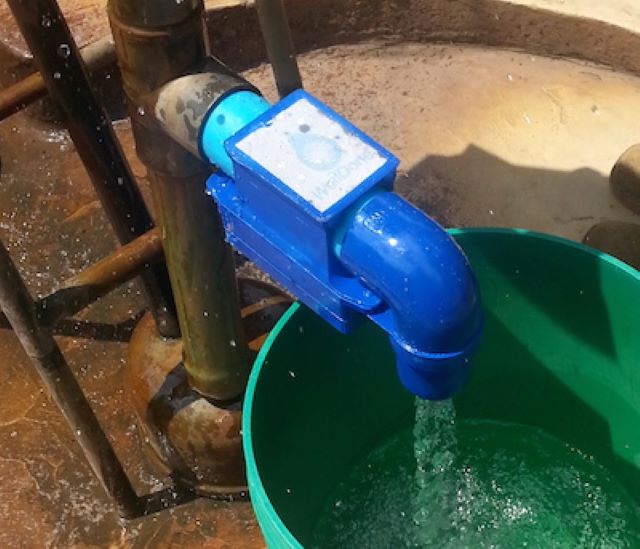Smart pump
This 3D printed prototype is an enclosure for a MoMo device that measures flow rate on a rope pump in rural Tanzania.
Contents |
[edit] Introduction
A smart pump is a pump that functions in a specific way under certain conditions. When connected through a network (as other devices operate by way of the Internet of Things) smart pumps communicate with each other and with those who operate them.
[edit] Basic smart pumps
Smart pumps can be used to prevent flooding. These devices are designed to respond to rising water conditions. When the water reaches a predetermined level, it completes a circuit. This causes the smart pump to operate. When the water level drops, the circuit is ‘broken’ and the pump stops.
In domestic applications, a smart sump pumping system is one that uses WiFi technology to send alert messages when flood conditions are possible. They can also relay messages about the condition of the pump if it malfunctions.
[edit] Telemetry
More advanced smart pumps use sensors or other Internet of Things (IoT) devices associated with telemetry to collect data. Telemetry is defined as data collection from remote points which is then automatically transmitted to monitoring equipment designed to receive the information. Because the data is collected automatically, technicians do not have to schedule visits to sites where the devices are operating unless it is physically necessary.
Some telemetry devices on smart pumps can communicate through SMS messages to send operational updates from remote locations. This is a relatively low cost method of communication with a wide coverage range.
[edit] Energy efficiency
Smart pumps can be used to optimise energy consumption and minimise pump lifecycle costs through reduced maintenance. These devices typically use pumps that are driven by variable frequency drives (VFDs) and can gather information regarding operating performance. Possible benefits may include:
Additional reductions may be realised by increased process automation and efficiency.
One drawback to smart pumps may be the slow acceptance of site technicians in water and wastewater treatment facilities, to support smart pumps. This may be due to lack of familiarity with the devices or concerns over the additional maintenance that may be required.
[edit] Smart pumps for remote communities
In certain parts of the world, the delivery of clean water is a challenge. To address this problem, UNICEF is researching the feasibility of deploying remote sensors and mobile technology in ways that can help make pumps smarter and enable them to improve sustainable access to clean water.
Through the use of real-time data, it will be possible to issue alerts when pumps malfunction, allowing for quicker repairs and less down time for communities in need of water. The monitoring systems will also collect prognostic information that can be used to help anticipate failures based on patterns and historical data. This will allow technicians to repair devices proactively before problems occur.
Exploratory projects include:
- SweetSense programme (developed with support from Portland State University). This sensor technology monitors performance of infrastructure including sanitation and water projects.
- Smart Handpumps (University of Oxford). These devices use a mobile data transmitter and an accelerometer linked to the pump handle to gather hourly pump usage data.
- MoMo mobile monitors (WellDone). This approach uses GSM-enabled units attached to handpumps, pipes and power systems to collect and send data through SMS messages that can be monitored for usage levels associated with water and energy infrastructure.
- MANTIS (Leeds Beckett University and Environmental Monitoring Systems). Short for Monitoring and Analytics to Improve Service, Mantis is looking to develop telemetry tools for post-construction monitoring of remote water points in developing regions.
[edit] Related articles on Designing Buildings Wiki
- Global smart water management.
- Internet of things IoT.
- Sump pump.
- Sustainable water management.
- Switch.
- Water engineering.
[edit] External resources
Featured articles and news
The Building Safety Forum at the Installershow 2025
With speakers confirmed for 24 June as part of Building Safety Week.
The UK’s largest air pollution campaign.
Future Homes Standard, now includes solar, but what else?
Will the new standard, due to in the Autumn, go far enough in terms of performance ?
BSRIA Briefing: Cleaner Air, Better tomorrow
A look back at issues relating to inside and outside air quality, discussed during the BSRIA briefing in 2023.
Restoring Abbotsford's hothouse
Bringing the writer Walter Scott's garden to life.
Reflections on the spending review with CIAT.
Retired firefighter cycles world to raise Grenfell funds
Leaving on 14 June 2025 Stephen will raise money for youth and schools through the Grenfell Foundation.
Key points for construction at a glance with industry reactions.
Functionality, visibility and sustainability
The simpler approach to specification.
Architects, architecture, buildings, and inspiration in film
The close ties between makers and the movies, with our long list of suggested viewing.
SELECT three-point plan for action issued to MSPs
Call for Scottish regulation, green skills and recognition of electrotechnical industry as part of a manifesto for Scottish Parliamentary elections.
UCEM becomes the University of the Built Environment
Major milestone in its 106-year history, follows recent merger with London School of Architecture (LSE).
Professional practical experience for Architects in training
The long process to transform the nature of education and professional practical experience in the Architecture profession following recent reports.
A people-first approach to retrofit
Moving away from the destructive paradigm of fabric-first.
International Electrician Day, 10 June 2025
Celebrating the role of electrical engineers from André-Marie Amperè, today and for the future.
New guide for clients launched at Houses of Parliament
'There has never been a more important time for clients to step up and ...ask the right questions'
The impact of recycled slate tiles
Innovation across the decades.
EPC changes for existing buildings
Changes and their context as the new RdSAP methodology comes into use from 15 June.


























Comments